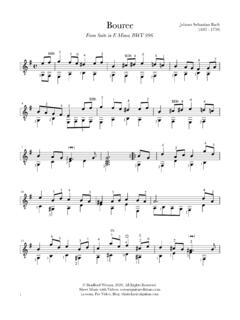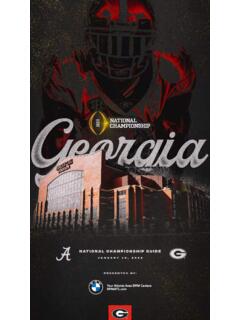Transcription of Classical Guitar Method
1 Classical Guitar Method Volume 1 By Bradford Werner 2020 Edition Classical Guitar Method - Volume 1 by Bradford Werner 2020 Edition Distributed by Bradford C. Werner, 2020. All Rights Reserved. Sharing Info This work is licensed under the Creative Commons Attribution-NonCommercial-NoDerivatives International License. You can share this work but must give credit and link to my site. You may not sell this work, use it for commercial purposes, alter it and/or distribute a modified version. Printing the PDF This PDF has been designed for double sided printing. Place it in a three ring binder with dividers for each section. You are not permitted to print and sell this book. Hard Copies Physical print editions of this book are available on Amazon Stores online.
2 2 Contents Part 1 - Progressive Method 9 Brief Definitions of Music Notation 12 Three Open Strings, Rhythms, Etude No. 1 and 2, Nocturne Duet 17 Notes on the Third String, Sight Reading, Moderato, A Fairy Tale Duet 21 Notes on the First and Second String, Note Review, Sight Reading, Five Melodies 26 Ode to Joy Duet, Sight Reading and Dynamics, Etude No. 3, Note Review 30 Twinkle Twinkle Little Star, Etude No. 4, Jazz Cat, Au clair de la lune, Oh Susana 35 Duets: Waltz by Czerny, Minuet by Wilton, Morning by Diabelli 38 Open Bass Strings, Etudes No. 5, 6, and 7 42 New Notes (C, D, E, F), Note Review, Etude No. 8, C Major Scale 46 Eighth Notes, Sight Reading, Angeline the Baker, Minuet Duet by Hook, Etude No.
3 9, 51 Vsi so venci Vejli, Flow Gently, Sweet Afton Duet 54 Two Voice Textures, Etude No. 10 and 11 57 Dotted Quartet Notes, Little Birch Tree in the Field, The Skye Boat Song 60 Fifth and Sixth String Notes, Note Review, Sight Reading, Leyenda Theme by Albeniz 66 Accidentals, Chromatic Scale, Greensleeves, Malague as, Minuet in G Duet by Petzold 71 Siciliano by Carcassi, Farewell Part 2 - Chord & Fingerstyle Accompaniment 73 Strumming: Hey Ho, Fr re Jacques, London Bridge, You Are My Sunshine, Amazing Grace, Red River Valley, Tom dooley , Danny Boy, Shenandoah, Scarborough Fair 84 Fingerstyle: Tablature Explanation, Scarborough Fair, Will the Circle Be Unbroken, Saint James Infirmary, House of the Rising Sun 88 Pentatonic Minor & Blues Scales, Twelve Bar Blues, The Shuffle, Rhythm Riff Blues Part 3 - Technique & Knowledge 92 Right Hand Technique Routine 94 Left Hand Technique Routine 95 Single String Chromatic Scales 98 Beginner Scales: E Chromatic, C Major, G Major, F Major, A Minor, E Minor, D, Minor Appendix 101 Basic Note Reference Chart 102 Chord Reference Chart 3 About this book This book teaches Classical and fingerstyle Guitar skills with a focus on the rich pedagogical tradition of Classical Guitar .
4 Most learning objectives are covered through pieces and duets rather than exercises or descriptions. This allows students to perform full pieces from the first lesson. Working with a qualified teacher as well as watching the lesson videos should provide students with a healthy start to Guitar . How to use this book Study Part 1 in order, covering every piece on every page. Simultaneously begin Part 3 as a technique routine. Part 2 (chords) can be studied more loosely based on the skills and age of the student. Watch the video lessons to help you learn proper technique, musicality, and listening skills. Free video lessons, an essential part of this Method The video lessons for this book are essential to the learning experience.
5 Ideas about musicality and technique are discussed and demonstrated in the videos. This book omits information that might clutter the beginner learning experience. Music should be learned through listening and experience. All the extra information and advice has been included in the free lesson videos which is a better medium for communicating musical ideas. Find the lessons at the Method book page at Werner Guitar Editions or This is Classical Guitar (also via the sheet music page or lesson page): Five main goals of this book solos and duets from start to finish with a steady tempo legato melodies (also with open string bass accompaniment) arpeggio pieces and patterns proficient at reading music in first position (without key signatures) basic songs with strumming or fingerstyle chords Educational Series (Further Study) Method Book Volume 2 - Continue your progress with new repertoire, techniques, key signatures, scales, time signatures; theory, musicality, rhythm training; new chords and more.
6 Repertoire Lessons Grade 1 to 6 - A dedicated book of lessons and repertoire for each grade. All the pieces come with dedicated lesson pages and video lessons to help you learn. Classical Guitar Technique, Essential Scales, Arpeggios, and Exercises - Routines for all levels, hundreds of exercises, video lessons. 4 Rest stroke or free stroke? Nails? Teachers have different opinions about the use of rest and free strokes for beginners. I have seen good results from both approaches. My beginner students use free stroke until proper hand positions and a relaxed legato playing style are established. Students need not introduce right hand nails until hand positions and posture are secure. I introduce rest strokes and nails during my Volume 2 Method .
7 Use of the left hand pinky finger Students should use the left hand pinky for D and G (3rd fret of the 1st and 2nd strings). This fingering is required for solo pieces later and helps align the left hand. Students will have no trouble using the pinky if it is curved and in the proper position. Music Theory I recommend the Berklee Music Theory Book 1 - Intro to theory which also includes an answer key. You don t really need all this theory info yet but if you re curious this is a good place to start. You can find the book link on my site or on Amazon here: Tuning the Guitar Students should buy a clip-on tuner, I like the D Addario Micro Tuner: Tuning by ear to the teacher should begin during the first lesson as well as relative tuning: the 6th string at the 5th fret and tune the open 5th string to the same pitch.
8 The 5th string at the 5th fret to tune the open 4th string. the 4th string at the 5th fret to tune the open 3rd string. the 3rd string at the 4th fret to tune the open 2nd string. the 2nd string at the 5th fret to tune the open 1st string. Follow the site for free Free and premium sheet music & tab: Free video lessons and instructional articles: Join the email newsletter for with lessons, sheet music, pro videos and more. Sign up at the website. 5 Practice Advice Happiness in small goals: Making your practice sessions enjoyable will be key to long-term musical success and development. When experiencing difficulties, break up the piece or exercise into small manageable goals at a speed you can accomplish successfully.
9 Even if you only play a few notes at a time, playing successfully will improve your skills and give you a feeling of accomplishment. Isolate difficulties and solidify strengths: Balance your practice sessions by working on difficulties as well as maintaining easy material you can play well. Playing at a high quality level as often as possible will help develop a solid foundation. Work on your difficulties near the middle of your practice session and finish with something you can play well. This will ensure you end with a positive feeling of success. Practicing is Problem Solving: Practicing is different than just playing the Guitar . When you practice you need to identify problems or elements you wish to improve and solve them immediately.
10 Simply playing the Guitar will not make you a better musician. If your teacher says you should practice for 30 minutes a day, be sure you are actually practicing for 30 minutes not just playing. Combine repetition with thoughtful practice: Although a certain amount of repetition is required to establish your skills, balance repetition with thoughtful reevaluation. Sometimes, improvement will occur by reexamining your posture, hand positions, or elements not directly connected to what you are studying. Having a qualified teacher is very helpful. They can identify problems before you repeat it a hundred times. That said, aim to be mindful at all times about what you are doing. Good days vs bad days: Actually, I don t believe in good or bad practice days.




